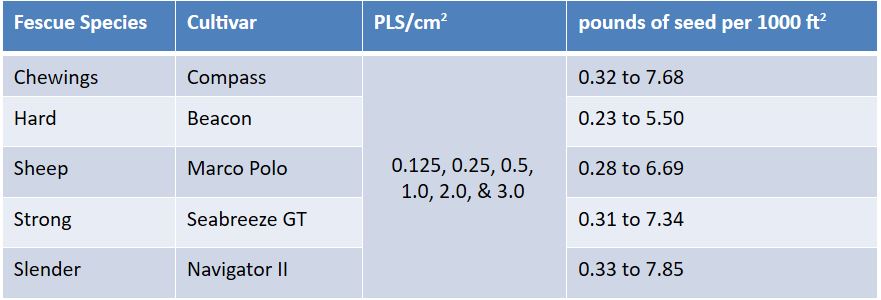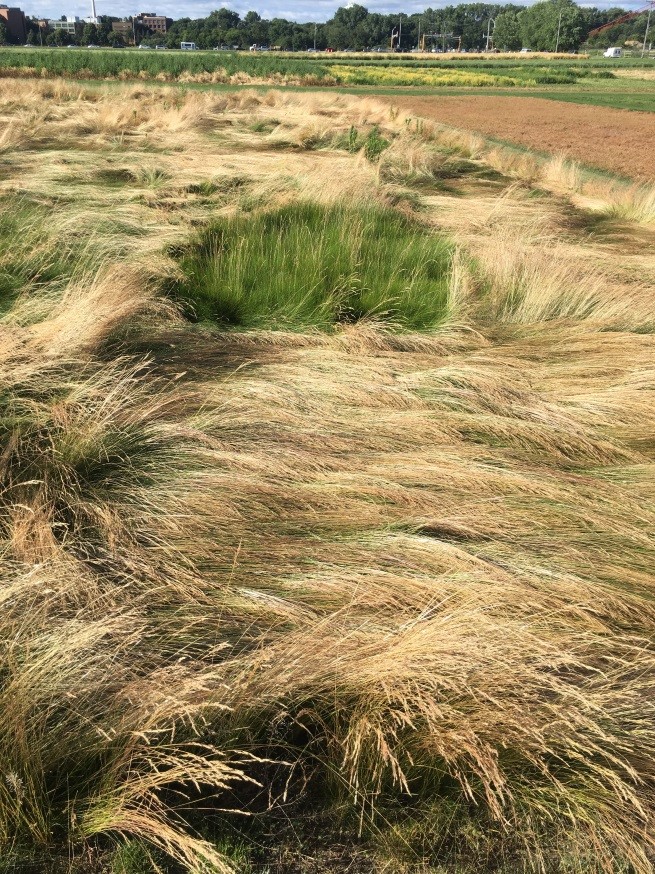By Andrew Hollman
With an increase in consciousness on the scarcity of resources, more consumers are looking for ways in which they can reduce their consumption. Turfgrass often comes under scrutiny for its use of water, fertilizers and pesticides. A nice-looking turf that doesn’t need to be mowed and takes very little maintenance is the dream of some homeowners and landscape managers. The sale of “No-Mow” seed mixtures has increased the interest of many people to establish or transition to lower maintenance turfgrass areas. The idea that these areas are “maintenance free” is a misnomer and without the proper grass selection and seeding rate, these areas can require a great deal of care. For that reason, research trials were established in August of 2015 and 2017 at the University of Minnesota St. Paul campus to examine the effect of species and seeding rate on turf maintained as a “No-Mow”.
For this trial, a single cultivar was used for each fine fescue species (Table 1): hard fescue (Festuca brevipila), sheep fescue (F. ovina), strong creeping red fescue (Festuca rubra ssp. rubra), slender creeping red fescue (F. rubra ssp. litoralis), and Chewings fescue (F. rubra ssp. fallax). The seeding rates used in this trial were calculated based on the number of pure live seeds (PLS) for a given area This method was used to take into account the variation in seed size that occurs within and between the fine fescue species, which we found in a previous study ranged from 282,000 seeds/pound to 776,000 seeds/pound.
After the fall establishment, plots did not receive any supplemental irrigation or fertility. Mowing was performed yearly at the end of July to remove seedheads and biomass longer than 5.5 inches. The plots were evaluated in the spring, summer and fall for the percentage of turf, weeds and bare areas using a line-intersect grid. The seedhead density of each plot was assessed through counts on one-square-foot frames and the overall turfgrass quality was rated monthly.
Preliminary results found that plots with the highest seeding rates had the best establishment. The strong and slender creeping red fescues along with Chewings fescue were quickest to fill in during the fall, while the hard and sheep fescue were much slower, even at the highest seeding rates. During the first full year after seeding, the highest seeding rates had lower numbers of weeds and higher turfgrass quality ratings. These high seeding rates also reduced the incidence of the seedheads falling over or lodging.
The production of seedheads (Figure 1) might be a concern for people using “No-Mow” grasses. When seedhead density is low, they add an aesthetic appeal and can contribute seed to the turf below to potentially fill in thin or dead areas. When seedhead density is too high, they create an excessive amount of biomass that needs to be removed and often impacts the intended use of the area. On golf courses, this can slow down the pace of play or create areas where balls cannot be found. In the first year after seeding in our study, the density of seedheads ranged from 1 to 418 seedheads per square foot. Extremely high densities were seen with the lowest seeding rates of hard and sheep fescue, while the lowest densities were seen with the highest seeding rates of Chewings fescue. In the second and third year the density of seedheads were reduced, with the highest densities only reaching into the 70s, while most plots were well below that. In year two, these were mainly obtained by the lowest seeding seeding rates of sheep, hard and Chewings fescue. In year three there was a shift, and the higher seeding rates of sheep and hard fescue still had seed densities over 50 seedheads per square foot.
The ability of the higher seeding rate plots of hard and sheep fescue to still produce an ample amount of seedheads in the third year of the study is likely related to their turf quality and density. The high seeding rate sheep and hard fescue plots maintained the best turf quality and a dense stand of grass for three years, while the strong and slender creeping red fescue plots showed a continued decline in their performance, with quality ratings approaching a level to indicate the plot was dead. Overall ‘Beacon’ hard fescue at 2 and 3 pure live seeds per cm2, (3.66 and 5.5 lbs/1000 ft2) performed the best for turf quality in a “No-Mow” setting (Figure 2). This range of seeding rates will be dependent on the cultivar used and its seed size, but in general, a seeding rate of 4.5 lbs of pure live seed per 1000 ft2 will be adequate for most hard fescues used in “No-Mow” lawn situations. Whether all hard fescues will perform similarly is a question to be addressed in future studies.


